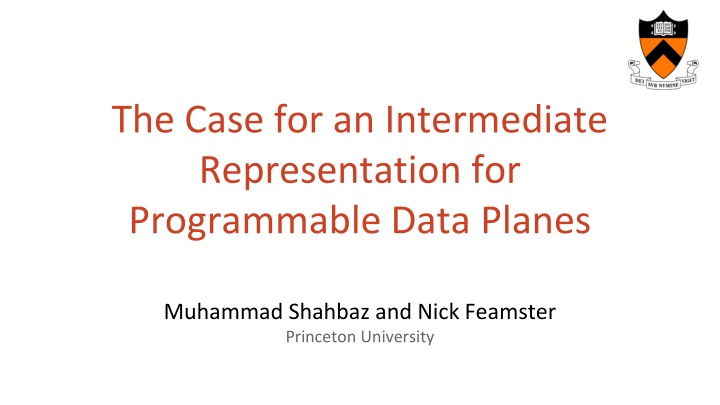
Optimizing Programmable Data Planes through Intermediate Representation
Explore the importance of an intermediate representation for programmable data planes to enhance flexibility in protocol handling and policy enforcement. Learn how NetASM provides a common platform for optimizing and compiling policies effectively, improving performance metrics like area, latency, and throughput.
Uploaded on | 0 Views
Download Presentation

Please find below an Image/Link to download the presentation.
The content on the website is provided AS IS for your information and personal use only. It may not be sold, licensed, or shared on other websites without obtaining consent from the author. If you encounter any issues during the download, it is possible that the publisher has removed the file from their server.
You are allowed to download the files provided on this website for personal or commercial use, subject to the condition that they are used lawfully. All files are the property of their respective owners.
The content on the website is provided AS IS for your information and personal use only. It may not be sold, licensed, or shared on other websites without obtaining consent from the author.
E N D
Presentation Transcript
The Case for an Intermediate Representation for Programmable Data Planes Muhammad Shahbaz and Nick Feamster Princeton University
Need for a Programmable Data Plane Protocol Independence (e.g., GRE, VXLAN, BFD) VXLAN ETH Payload ETH Payload ETH Payload P0 ETH == ETHy LD VXLAN LD ETH VXLAN.IP == IPx POP VXLAN SEND P0 Data Plane To enable this, data plane needs to be able to 1) Operate on arbitrary packet locations 2) Accept packet processing operations using high-level policies (or language) Policy
Compiling Policy b. generate policy Switc h Parse ETH Parse IP Parse TCP a. git clone DC Parse ETH Parse IP ACL HUB LB Router ACL c. install policy However, there is an issue here - ACL might only be operating on IP src/dst - In which case, rest of the fields are dead - A na ve compilation will add these dead fields in the data plane Data Plane
NetASM: An Intermediate Representation Enables a common platform for writing optimizations for programmable data planes NetASM Design Features - Provides an abstract data plane model - Two kinds of state a. Per-packet state (e.g., fields) b. Persistent state (e.g., tables) - Modes of execution a. Sequential for invoking pipelined parallelism b. Concurrent for latency sensitive applications c. Atomic for stateful operations using shared state - 23 primitive instructions
Compiling Policy using NetASM Parse ETH Parse IP ACL NetASM acts as a common (intermediate) layer - Improves quality of code using optimizations like code-motion and dead-code/store elimination - Performs conventional data and control flow analyses - Uses target agnostic and specific cost model - Improves for metrics like area, latency, and throughput NetASM Common (Intermediate) Layer Data Plane
Preliminary Evaluations - ACL-IPv4 benchmark from ONF Github repository https://github.com/NetASM/ACL-IPv4-Example - Results using our abstract cost model (details in the paper)
Future Work P4 Click CNC Complete the language specification for NetASM Front end Explore opportunities for optimizations that can be applied across different classes of target architectures Compiler NetASM Back end RMT FPGA NPU 2 1 3
Summary - NetASM is an intermediate representation for Programmable Data Planes - Enables a common platform for optimizing high-level packet processing programs for a diversity of targets - Leads to better architectural explorations
Questions? www.netasm.org Muhammad Shahbaz mshahbaz@cs.princeton.edu
